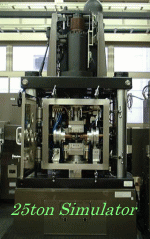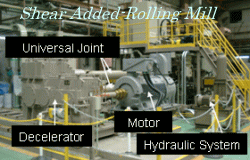Development of the ultra-fine grained Ferrite structure.
| Proposal of the best way of the formation of ultra-fine grained structure by numerical analysis. | |||
| Ultra-fine grain Structure is the important keyward for the steel with high reliability or quality. Plastic strain��induced in steel plays an important role in refinement crystal grains. The deformation techniques for introducing, ECAP(Equal Channel Angular Pressing), MM(Mechanical Milling), ARB(Accumulative Roll Bonding), MDD(Multi-Directional Deformation), and so on. The deformation mode is generally devided into two types, the compressive mode and the shear mode. |
|||
| The Uni-directional Deformation As illustrated Fig. right, the mean grain size of ferrite that has been transformed from deformed and unrecrystallised austenite becomes finer with an increase in the plastic strain induced in the austenite. Accrdingly when a uniformly fine grained structure is desired in the transformed ferrite, the homogeneous destribution of a large amount of plastic strain has to be introduced in the austenite region throughout the material. For this purpose, heavy deformation, such as rolling, is required for unidirectional deformation. However, the plastic strain often localises at some part of thickness, and does not always spread out over the entire material. Thus it is difficult to produce a uniformly fine grained ferrite structure throughout the thickness. To obtain a uniformly fine structure, the fundamental results in Fig. right should be examined. Stage �T�F��eq < 0.15 The grain size does not change. Stage �U�F0.15<��eq <2.0 The grain size is proportional to ��eq-1/3 . Stage �V�F��eq >2.0 The grain size is almost constant. |
The grain size becomes constant at the strain range of�Á���cri .If the plastic strain over 2.0 can be introduced in the material, the fine ferrite grain will form uniformly over the material. |
||
| The Multi-directional Deformation A large plastic strain in the austenite region is necessary for the effective refinement of ferrite grains that are transformed from deformed and unrecrystallized austenite. The multi-directional deformation can be proposed as a method to introduce widely large equivalent plastic strain in the material. The effectiveness was first clarified using FE-analysis. Thermo-mechanical treatment with a developed multi-direction deformation thermo-mechanical treatment simulator confirmed it experimentally. The fine ferrite grain structure through bi-directional deformation exhibits a wider region in comparison with that through uni-directional deformation. The multi-directional deformation should be applied to obtain ultra-fine grain structure for thick products of steels. |
 |
||
| The Shear Deformation The relationship between the equivalent plastic strain ��eq obtained by FE analysis and the mean size d�� of the ferrite grains after thermomechanical treatment was shown to compare the effect of the deformation mode. The d�� is proportional to ��eq-��, and the exponent �� in the area with a shear strain ��xy is larger than that in the area without ��xy. Namely, the ferrite grain size in the area with ��xy becomes finer than in the area without ��xy under the same ��eq. The result of this is that the austenite grain boundary surface area per unit volume Sdv(g.b) in the area with the shear strain becomes larger than Sdv(g.b in the area without it. The relationship between the ferrite grain size d�� and the ratio SV(g,b) of the surface area before and after deformation is represented by folllowing equation. K: Constant given in micrometres |
 |
||
